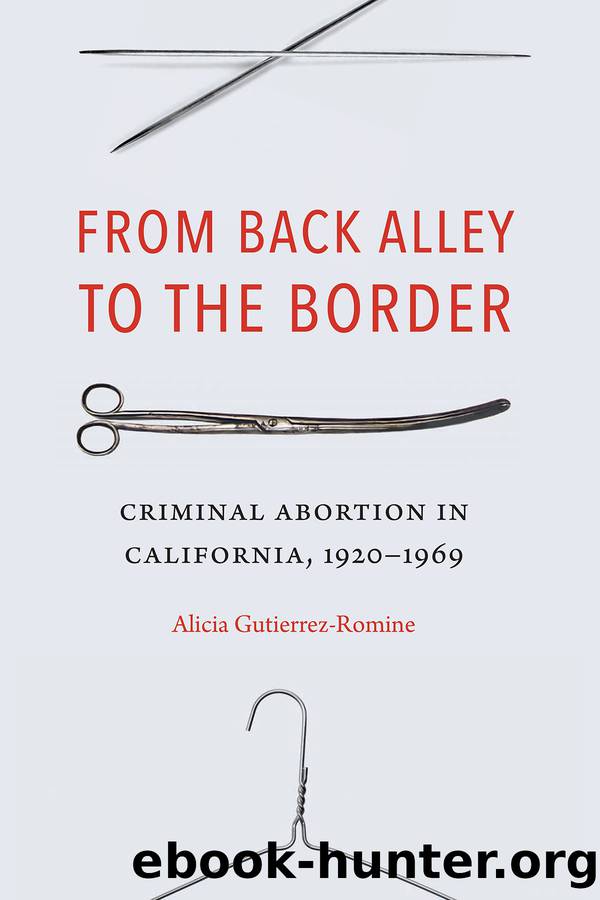From Back Alley to the Border: Criminal Abortion in California, 1920-1969 by Alicia Gutierrez-Romine

Author:Alicia Gutierrez-Romine [Gutierrez-Romine, Alicia]
Language: eng
Format: epub
Tags: HIS036140 History / United States / State & Local / West (ak, Ca, Co, Hi, Id, Mt, Nv, Ut, Wy), SOC028000 Social Science / Women's Studies, SOC046000 Social Science / Abortion & Birth Control
Publisher: Nebraska
4. Jewel Inez Joseph (mother of Ruth Attaway, who died after an abortion) in court, Los Angeles, 1935. Los Angeles Times Photographic Archive. Department of Special Collections, Charles E. Young Research Library, UCLA.
From the very beginning Rankin suspected that Wilson would give him trouble. He accused Wilson of misreporting numbers, hiding receipts, and pocketing money for himself. Perhaps more significant, Rankin suspected that Wilson was pulling De Gaston away from him.39 Rankinâs concerns were appropriate. With the autonomy Wilson and De Gaston had in Seattleâfar from Los Angelesâthey thrived. Wilson began to think they didnât need Rankin at all and often wondered why they were sending half of their profits to him. Wilson began to complain regularly and often mused that they were better off without Rankin. Wilson told Rankin they didnât need him and that if Rankin wanted them to stick around, he needed to fix his management style, promptly settle MAC accounts, and streamline the paperwork process. Rankin tried to propitiate Wilson. He even allowed Wilson to purchase a share of the business in the office. But it was not enough. Wilson continued to push until Rankin finally relented. On November 20, 1935, Rankin sold Wilson all of his interest in the office in the Securities Building, andâperhaps worst of allâhe ceded De Gastonâs services to Wilson as part of that sale.
Rankin regretted the sale immediately. He despised Wilsonâs independence and thought of all the money they were making without him. He wanted De Gaston back. For the next month Rankin wrote De Gaston tirelessly. He told De Gaston he would have him back and that Wilsonâs actions were going to get them in trouble. Even though Rankin had tried to prevent his abortionists from claiming ownership of their clinics, he had failed to do so with Wilson. Moreover, Wilson had taken De Gastonâthe man in whom Rankin had investedâwith him.
By April 1936 Rankin used his connections to act on his threats against Wilson and De Gaston and had them both arrested. De Gaston and Wilsonâs attorney made the arrest a spectacle and claimed that his clients had been âframedâ for defying Rankinâs âcoastwide abortion syndicate.â40 This claim garnered wide publicity. It was the first time many in law enforcement had heard about the expansive syndicate. Rankinâs efforts to exact revenge ultimately backfired: they piqued the interests of Captain Charles Dullea and Inspectors George Engler and Harry Husted of the San Francisco Police Department (SFPD) and brought about the ringâs demise.
At the end of a routine investigation into another abortion-related death in San Francisco, the SFPD investigators asked BME secretary-treasurer Pinkham if the âsensational stories about a hundred-million-dollar abortion syndicate on the Pacific Coastâ were true.41 Pinkham claimed they were but that there was little his office could do about the syndicate because of the way that its abortionists moved around and how well it paid off some doctors and law enforcement officers. This was a sort of dare that compelled the San Francisco investigators to look into PCAR.
Download
This site does not store any files on its server. We only index and link to content provided by other sites. Please contact the content providers to delete copyright contents if any and email us, we'll remove relevant links or contents immediately.
| African Americans | Civil War |
| Colonial Period | Immigrants |
| Revolution & Founding | State & Local |
Cat's cradle by Kurt Vonnegut(13895)
Pimp by Iceberg Slim(12946)
Underground: A Human History of the Worlds Beneath Our Feet by Will Hunt(11266)
4 3 2 1: A Novel by Paul Auster(11074)
The Radium Girls by Kate Moore(10916)
American History Stories, Volume III (Yesterday's Classics) by Pratt Mara L(4829)
Perfect Rhythm by Jae(4628)
Wiseguy by Nicholas Pileggi(4601)
The Fire Next Time by James Baldwin(4351)
Paper Towns by Green John(4178)
A Higher Loyalty: Truth, Lies, and Leadership by James Comey(4040)
Pale Blue Dot by Carl Sagan(4017)
The Mayflower and the Pilgrims' New World by Nathaniel Philbrick(3918)
The Doomsday Machine by Daniel Ellsberg(3737)
Too Much and Not the Mood by Durga Chew-Bose(3700)
Killers of the Flower Moon: The Osage Murders and the Birth of the FBI by David Grann(3623)
The Borden Murders by Sarah Miller(3594)
The Sympathizer by Viet Thanh Nguyen(3516)
Killing England by Bill O'Reilly(3461)
